Transitioning to Low-Carbon Economies under the 2030 Agenda: Minimizing Trade-Offs and Enhancing Co-Benefits of Climate-Change Action for the SDGs
Abstract
1. Introduction
2. Materials and Methods
- Time horizon (when) → Indicates that a policy impact may manifest in the opposite direction in the short term as opposed to the long term;
- Local (geographical) (where) → Indicates that the policy impact’s occurrence or magnitude would be influenced by the location where a specific project is implemented, or where a measure takes effect;
- Governance (how) → Indicates that the policy impact occurrence and magnitude relate to the implementation approach through: choice of technology or (guidelines on) processes, or applicability of policy. This dimension does not cover governance effectiveness or other aspects of governance; and
- Natural resources (i.e., limited fuels) (what) → Indicates that the policy impact occurrence and magnitude depend on availability of limited natural resources nationally (in particular fossil and radioactive fuels). This category does not include renewable energy resources.
3. Results and Discussion
3.1. Identification of Climate-Change Mitigation Impacts on the SDGs
3.2. Relevance of Context Dimensions in Addressing Climate-Change–SDG Impacts
3.3. Prominence of Context Dimensions across Climate-Change–SDG Impacts
3.4. Choice of Climate-Change Mitigation Measures in the G20 Member States
4. Conclusions
Supplementary Materials
Author Contributions
Funding
Institutional Review Board Statement
Informed Consent Statement
Data Availability Statement
Acknowledgments
Conflicts of Interest
References
- UNFCCC. Paris Agreement Decision 1/CP.21—Report of the Conference of the Parties on its Twenty-First Session, Held in Paris from 30 November to 13 December 2015 Addendum Part Two: Action Taken by the Conference of the Parties at Its Twenty-First Session; United Nations Framework Convention on Climate Change: Bonn, Germany, 2015. [Google Scholar]
- Intergovernmental Panel on Climate Change. Summary for Policymakers. In Climate Change 2013—The Physical Science Basis: Working Group I Contribution to the Fifth Assessment Report of the Intergovernmental Panel on Climate Change; Cambridge University Press: Cambridge, UK, 2014; pp. 1–30. [Google Scholar] [CrossRef]
- Joy, J.; Tschakert, P.; Waisman, H.; Abdul Halim, S.; Antwi-Agyei, P.; Dasgupta, P.; Hayward, B.; Kanninen, M.; Liverman, D.; Okereke, C.; et al. Sustainable Development, Poverty Eradication and Reducing Inequalities. Global Warming of 1.5 °C. An IPCC Special Report on the Impacts of Global Warming of 1.5 °C above Pre-Industrial Levels and Related Global Greenhouse Gas Emission Pathways, in the Context of Strengthening the Global Response to the Threat of Climate Change. 2018. Available online: https://www.ipcc.ch/site/assets/uploads/sites/2/2019/02/SR15_Chapter5_Low_Res.pdf (accessed on 15 October 2020).
- Hoegh-Guldberg, O.; Jacob, D.; Bindi, M.; Brown, S.; Camilloni, I.; Diedhiou, A.; Djalante, R.; Ebi, K.; Engelbrecht, F.; Guiot, J.; et al. Impacts of 1.5 °C of Global Warming on Natural and Human Systems. Global Warming of 1.5 °C. An IPCC Special Report on the Impacts of Global Warming of 1.5 °C above Pre-Industrial Levels and Related Global Greenhouse Gas Emission Pathways, in the Context of Strengthening the Global Response to the Threat of Climate Change. 2018. Available online: https://www.ipcc.ch/site/assets/uploads/sites/2/2019/05/SR15_Chapter3_Low_Res.pdf (accessed on 15 October 2020).
- Dzebo, A.; Janetschek, H.; Brandi, C.; Iacobuta, G. Connections Between the Paris Agreement and the 2030 Agenda. The Case for Policy Coherence; Stockholm Environment Institute: Stockholm, Sweden, 2019. [Google Scholar]
- ICSU; ISSC. Review of Targets for the Sustainable Development Goals: The Science Perspective; International Council for Science: Paris, France, 2015. [Google Scholar]
- Shawoo, Z.; Dzebo, A.; Hägele, R.; Iacobuta, G.; Chan, S.; Muhoza, C.; Osano, P.; Fracisco, M.; Persson, Å.; Linner, B.-O.; et al. Increasing Policy Coherence Between NDCs and SDGs: A National Perspective; Stockholm Environment Institute: Stockholm, Sweden, 2020; pp. 1–8. [Google Scholar]
- Von Stechow, C.; Minx, J.C.; Riahi, K.; Jewell, J.; McCollum, D.; Callaghan, M.W.; Bertram, C.; Luderer, G.; Baiocchi, G. 2 °C and SDGs: United they stand, divided they fall? Environ. Res. Lett. 2016, 11, 034022. [Google Scholar] [CrossRef]
- Von Stechow, C.; McCollum, D.; Riahi, K.; Minx, J.C.; Kriegler, E.; Van Vuuren, D.P.; Jewell, J.; Robledo-Abad, C.; Hertwich, E.; Tavoni, M.; et al. Integrating global climate change mitigation goals with other sustainability objectives: A synthesis. Annu. Rev. Environ. Resour. 2015, 40, 363–394. [Google Scholar] [CrossRef]
- UNEP. The Emissions Gap Report; United Nations: New York, NY, USA, 2016. [Google Scholar]
- Randers, J.; Rockström, J.; Stoknes, P.-E.; Goluke, U.; Collste, D.; Cornell, S.E.; Donges, J. Achieving the 17 Sustainable Development Goals within 9 planetary boundaries. Glob. Sustain. 2019, 2, e24. [Google Scholar] [CrossRef]
- Dzebo, A.; Janetschek, H.; Brandi, C.; Iacobuta, G. Exploring Connections between the Paris Agreement and the 2030 Agenda for Sustainable Development; Stockholm Environment Institute: Stockholm, Sweden, 2017; p. 4. [Google Scholar]
- Janetschek, H.; Brandi, C.; Dzebo, A.; Hackmann, B. The 2030 agenda and the Paris agreement: Voluntary contributions towards thematic policy coherence. Clim. Policy 2019, 20, 430–442. [Google Scholar] [CrossRef]
- Nordhaus, W.D. Economic growth and climate—The carbon dioxide problem. Am. Econ. Rev. 1977, 67, 341–346. [Google Scholar]
- Beg, N.; Morlot, J.C.; Davidson, O.; Afrane-Okesse, Y.; Tyani, L.; Denton, F.; Sokona, Y.; Thomas, J.P.; La Rovere, E.L.; Parikh, J.K.; et al. Linkages between climate change and sustainable development. Clim. Policy 2002, 2, 129–144. [Google Scholar] [CrossRef]
- Swart, R. Climate change and sustainable development: Expanding the options. Clim. Policy 2003, 3, S19–S40. [Google Scholar] [CrossRef]
- IPCC. Climate Change 2014: Mitigation of Climate Change. Contribution of Working Group III to the Fifth Assessment Report of the Intergovernmental Panel on Climate Change; Cambridge University Press: Cambridge, UK, 2014. [Google Scholar]
- Kok, M.; Metz, B.; Verhagen, J.; Van Rooijen, S. Integrating development and climate policies: National and international benefits. Clim. Policy 2008, 8, 103–118. [Google Scholar] [CrossRef]
- Radu, O.B.; Berg, M.V.D.; Klimont, Z.; Deetman, S.; Janssens-Maenhout, G.; Muntean, M.; Heyes, C.; Dentener, F.; van Vuuren, D.P. Exploring synergies between climate and air quality policies using long-term global and regional emission scenarios. Atmos. Environ. 2016, 140, 577–591. [Google Scholar] [CrossRef]
- Maione, M.; Fowler, D.; Monks, P.; Reis, S.; Rudich, Y.; Williams, M.; Fuzzi, S. Air quality and climate change: Designing new win-win policies for Europe. Environ. Sci. Policy 2016, 65, 48–57. [Google Scholar] [CrossRef]
- Bollen, J.; Hers, S.; van der Zwaan, B. An integrated assessment of climate change, air pollution, and energy security policy. Energy Policy 2010, 38, 4021–4030. [Google Scholar] [CrossRef]
- Hasegawa, T.; Fujimori, S.; Havlik, P.; Valin, H.; Bodirsky, B.L.; Doelman, J.C.; Fellmann, T.; Kyle, P.; Koopman, J.F.L.; Lotze-Campen, H.; et al. Risk of increased food insecurity under stringent global climate change mitigation policy. Nat. Clim. Chang. 2018, 8, 699–703. [Google Scholar] [CrossRef]
- Fujimori, S.; Hasegawa, T.; Rogelj, J.; Su, X.; Havlik, P.; Krey, V.; Takahashi, K.; Riahi, K. Inclusive climate change mitigation and food security policy under 1.5 °C climate goal. Environ. Res. Lett. 2018, 13, 074033. [Google Scholar] [CrossRef]
- Guivarch, C.; Monjon, S. Identifying the main uncertainty drivers of energy security in a low-carbon world: The case of Europe. Energy Econ. 2017, 64, 530–541. [Google Scholar] [CrossRef]
- Chakravarty, S.; Tavoni, M. Energy poverty alleviation and climate change mitigation: Is there a trade off? Energy Econ. 2013, 40, S67–S73. [Google Scholar] [CrossRef]
- Ürge-Vorsatz, D.; Herrero, S.T. Building synergies between climate change mitigation and energy poverty alleviation. Energy Policy 2012, 49, 83–90. [Google Scholar] [CrossRef]
- Solaymani, S.; Kardooni, R.; Yusoff, S.B.; Kari, F. The impacts of climate change policies on the transportation sector. Energy 2015, 81, 719–728. [Google Scholar] [CrossRef]
- Nerini, F.F.; Tomei, J.; To, L.S.; Bisaga, I.; Parikh, P.; Black, M.; Borrion, A.; Spataru, C.; Broto, V.C.; Anandarajah, G.; et al. Mapping synergies and trade-offs between energy and the sustainable development goals. Nat. Energy 2017, 3, 10–15. [Google Scholar] [CrossRef]
- Mccollum, D.L.; Echeverri, L.G.; Busch, S.; Pachauri, S.; Parkinson, S.; Rogelj, J.; Krey, V.; Minx, J.C.; Nilsson, M.; Stevance, A.-S.; et al. Connecting the sustainable development goals by their energy inter-linkages. Environ. Res. Lett. 2018, 13, 033006. [Google Scholar] [CrossRef]
- Nerini, F.F.; Sovacool, B.; Hughes, N.; Cozzi, L.; Cosgrave, E.; Howells, M.; Tavoni, M.; Tomei, J.; Zerriffi, H.; Milligan, B. Connecting climate action with other sustainable development goals. Nat. Sustain. 2019, 2, 674–680. [Google Scholar] [CrossRef]
- Gonzales-Zuñiga, S.; Roeser, F.; Rawlins, J.; Luijten, J.; Granadillos, J. SCAN (SDG & Climate Action Nexus) Tool: Linking Climate Action and the Sustainable Development Goals, Key Findings Note. 2018. Available online: https://ambitiontoaction.net/wp-content/uploads/2019/04/Key_findings_final.pdf (accessed on 15 October 2020).
- Winkler, H.; Höhne, N.; Elzen, M.D. Methods for quantifying the benefits of sustainable development policies and measures (SD-PAMs). Clim. Policy 2008, 8, 119–134. [Google Scholar] [CrossRef]
- Winkler, H.; Boyd, A.; Gunfaus, M.T.; Raubenheimer, S. Reconsidering development by reflecting on climate change. Int. Environ. Agreem. Polit-Law Econ. 2015, 15, 369–385. [Google Scholar] [CrossRef]
- Nilsson, M.; Griggs, D.; Visbeck, M. Policy: Map the interactions between sustainable development goals. Nature 2016, 534, 320–322. [Google Scholar] [CrossRef]
- Nilsson, M.; Chisholm, E.; Griggs, D.; Howden-Chapman, P.; McCollum, D.; Messerli, P.; Neumann, B.; Stevance, A.-S.; Visbeck, M.; Stafford-Smith, M. Mapping interactions between the sustainable development goals: Lessons learned and ways forward. Sustain. Sci. 2018, 13, 1489–1503. [Google Scholar] [CrossRef]
- Nascimiento, L.; Kuramochi, T.; Iacobuţă, G.; Fekete, H.; den Elzen, M.; Weishaupt, M.; van Soest, H.L.; Roelfsema, M.; de Vivero-Serrano, G.; Lui, S.; et al. Twenty Years of Climate Policy: G20 Coverage Increased, but Important Gaps Remain. Unpublished Work. 2021. [Google Scholar]
- Coopman, A.; Osborn, D.; Ullah, F.; Auckland, E.; Long, G. Seeing the Whole: Implementing the SDGs in an Integrated and Coherent Way; Bioregional and Newcastle University: Newcastle, UK, 2016. [Google Scholar]
- International Council for Science. A Guide to SDG Interactions: From Science to Implementation; International Council for Science: Paris, France, 2017. [Google Scholar] [CrossRef]
- Nilsson, M. Important Interactions among the Sustainable Development Goals under Review at the High-Level Political Forum 2017; Stockholm Environment Institute: Stockholm, Sweden, 2017; p. 46. [Google Scholar]
- Weitz, N.; Carlsen, H.; Nilsson, M.; Skånberg, K. Towards systemic and contextual priority setting for implementing the 2030 agenda. Sustain. Sci. 2017, 13, 531–548. [Google Scholar] [CrossRef]
- Brandl, P.; Soltani, S.M.; Fennell, P.; Mac Dowell, N. Evaluation of cooling requirements of post-combustion CO2 capture applied to coal-fired power plants. Chem. Eng. Res. Des. 2017, 122, 1–10. [Google Scholar] [CrossRef]
- Hirth, L.; Ueckerdt, F. Redistribution effects of energy and climate policy: The electricity market. Energy Policy 2013, 62, 934–947. [Google Scholar] [CrossRef]
- Cameron, C.; Pachauri, S.; Rao, N.; McCollum, D.; Rogelj, J.; Riahi, K. Policy trade-offs between climate mitigation and clean cook-stove access in South Asia. Nat. Energy 2016, 1, 15010. [Google Scholar] [CrossRef]
- Vogt-Schilb, A.; Hallegatte, S. Climate policies and nationally determined contributions: Reconciling the needed ambition with the political economy. Wiley Interdiscip. Rev. Energy Environ. 2017, 6, e256. [Google Scholar] [CrossRef]
- Katila, P.; Jong, W.; Galloway, G.; Pokorny, B.; Pacheco, P. Harnessing Community and Smallholder Forestry for Sustainable Development Goals Building on Synergies; International Union of Forest Research Organizations: Vienna, Austria, 2017. [Google Scholar]
- De Jong, W.; Pokorny, B.; Katila, P.; Galloway, G.; Pacheco, P. Community forestry and the sustainable development goals: A two way street. Forests 2018, 9, 331. [Google Scholar] [CrossRef]
- Winkler, H. Reducing energy poverty through carbon tax revenues in South Africa. J. Energy S. Afr. 2017, 28, 12. [Google Scholar] [CrossRef]
- Lotze-Campen, H.; Popp, A.; Beringer, T.; Müller, C.; Bondeau, A.; Rost, S.; Lucht, W. Scenarios of global bioenergy production: The trade-offs between agricultural expansion, intensification and trade. Ecol. Model. 2010, 221, 2188–2196. [Google Scholar] [CrossRef]
- Taheripour, F.; Hertel, T.W.; Liu, J. The role of irrigation in determining the global land use impacts of biofuels. Energy Sustain. Soc. 2013, 3, 4. [Google Scholar] [CrossRef]
- Hoogeveen, J.; Faurès, J.-M.; Van De Giessen, N. Increased biofuel production in the coming decade: To what extent will it affect global freshwater resources? Irrig. Drain. 2009, 58, S148–S160. [Google Scholar] [CrossRef]
- Fankhauser, S.; Sehlleier, F.; Stern, N. Climate change, innovation and jobs. Clim. Policy 2008, 8, 421–429. [Google Scholar] [CrossRef]
- Lehr, U.; Lutz, C.; Edler, D. Green jobs? Economic impacts of renewable energy in Germany. Energy Policy 2012, 47, 358–364. [Google Scholar] [CrossRef]
- Louie, E.P.; Pearce, J.M. Retraining investment for U.S. transition from coal to solar photovoltaic employment. Energy Econ. 2016, 57, 295–302. [Google Scholar] [CrossRef]
- Healy, N.; Barry, J. Politicizing energy justice and energy system transitions: Fossil fuel divestment and a “just transition”. Energy Policy 2017, 108, 451–459. [Google Scholar] [CrossRef]
- Harrahill, K.; Douglas, O. Framework development for ‘just transition’ in coal producing jurisdictions. Energy Policy 2019, 134. [Google Scholar] [CrossRef]
- Oei, P.-Y.; Brauers, H.; Herpich, P. Lessons from Germany’s hard coal mining phase-out: Policies and transition from 1950 to 2018. Clim. Policy 2019, 20, 963–979. [Google Scholar] [CrossRef]
- Altieri, K.; Trollip, H.; Caetano, T.; Hughes, A.; Merven, B.; Winkler, H. Achieving development and mitigation objectives through a decarbonization development pathway in South Africa. Clim. Policy 2016, 16, S78–S91. [Google Scholar] [CrossRef]
- Fricko, O.; Parkinson, S.; Johnson, N.; Strubegger, M.; Van Vliet, M.T.; Riahi, K. Energy sector water use implications of a 2 °C climate policy. Environ. Res. Lett. 2016, 11, 034011. [Google Scholar] [CrossRef]
- Khreis, H.; May, A.D.; Nieuwenhuijsen, M. Health impacts of urban transport policy measures: A guidance note for practice. J. Transp. Health 2017, 6, 209–227. [Google Scholar] [CrossRef]
- Bastagli, F.; Hagen-Zanker, J.; Harman, L.; Barca, V.; Sturge, G.; Schmidt, T.; Pellerano, L. Cash Transfers: What Doest the Evidence Say? A Rigorous Review of Programme Impact and of the Role of Design and Implementation Features; Overseas Development Institute: London, UK, 2016. [Google Scholar]
- Beck, M.; Rivers, N.; Wigle, R.; Yonezawa, H. Carbon tax and revenue recycling: Impacts on households in British Columbia. Resour. Energy Econ. 2015, 41, 40–69. [Google Scholar] [CrossRef]
- Murray, B.; Rivers, N. British Columbia’s revenue-neutral carbon tax: A review of the latest “grand experiment” in environmental policy. Energy Policy 2015, 86, 674–683. [Google Scholar] [CrossRef]
- Combet, E.; Ghersi, F.; Hourcade, J.C.; Théry, D. Carbon Tax and Equity: The Importance of Policy Design; Critical, I., Dias Soares, C., Milne, J., Ashiabor, H., Deketelaere, K., Kreiser, L., Eds.; Oxford University Press: Oxford, UK, 2010; pp. 277–295. [Google Scholar]
- Cerutti, P.O.; Lescuyer, G.; Tsanga, R.; Kassa, S.N.; Mapangou, P.R.; Mendoula, E.E.; Nasi, R.; Eckebil, T.P.P.; Yembe, Y.R. Social Impacts of the Forest Stewardship Council Certification: An Assessment in the Congo Basin; CIFOR: Bogor, Indonesia, 2014. [Google Scholar]
- Sikkema, R.; Junginger, M.; Van Dam, J.; Stegeman, G.; Durrant, D.; Faaij, A. legal harvesting, sustainable sourcing and cascaded use of wood for bioenergy: Their coverage through existing certification frameworks for sustainable forest management. Forests 2014, 5, 2163–2211. [Google Scholar] [CrossRef]
- Sakai, P.; Afionis, S.; Favretto, N.; Stringer, L.C.; Ward, C.; Sakai, M.; Neto, P.H.W.; Rocha, C.H.; Gomes, J.A.; De Souza, N.M.; et al. Understanding the implications of alternative bioenergy crops to support smallholder farmers in Brazil. Sustainability 2020, 12, 2146. [Google Scholar] [CrossRef]
- Harstad, B. Buy coal! A case for supply-side environmental policy. J. Politi-Econ. 2012, 120, 77–115. [Google Scholar] [CrossRef]
- Asheim, G.B.; Fæhn, T.; Nyborg, K.; Greaker, M.; Hagem, C.; Harstad, B.; Hoel, M.O.; Lund, D.; Rosendahl, K.E. The case for a supply-side climate treaty. Science 2019, 365, 325–327. [Google Scholar] [CrossRef]
- Horst, K.J.; Rothwell, G.; Cometto, M.; Deffrennes, M.; Iracane, D.; Ha, J.; Paillere, H.; Aspelund, K.; Aydil, I.; Berthelemy, M.; et al. The Full Costs of Electricity Provision; Nuclear Energy Agency of the OECD: Paris, France, 2018. [Google Scholar]
- Ouyang, X.; Lin, B. Levelized cost of electricity (LCOE) of renewable energies and required subsidies in China. Energy Policy 2014, 70, 64–73. [Google Scholar] [CrossRef]
- Brandi, C.; Blümer, D.; Morin, J.-F. When do international treaties matter for domestic environmental legislation? Glob. Environ. Polit. 2019, 19, 14–44. [Google Scholar] [CrossRef]
- Rantala, S.; Iacobuta, G.; Minestrini, S.; Tribukait, J. Gaps and opportunities for synergies in international environmental law on climate and biodiversity to promote the sustainable development goals. In 2019 International Environmental Law-Making and Diplomacy Review; Honkonen, T., Romppanen, S., Eds.; University of Eastern Finland: Joensuu, Finland, 2020; pp. 58–59. [Google Scholar]
- Azizi, D.; Biermann, F.; Kim, R.E. Policy integration for sustainable development through multilateral environmental agreements. Glob. Gov. 2019, 25, 445–475. [Google Scholar] [CrossRef]
- UN. Gaps in International Environmental Law and Environment-Related Instruments: Towards a Global Pact for the environment. Report of the Secretary-General; Report: A/73/419*; UN: New York, NY, USA, 2018. [Google Scholar]
- Dombrowsky, I.; Hensengerth, O. Governing the water-energy-food nexus related to hydropower on shared rivers—The role of regional organizations. Front. Environ. Sci. 2018, 6, 153. [Google Scholar] [CrossRef]
- Bauer, S.; Kurdziel, M.J.; Iacobuta, G.; Brandi, C.; Rodriguez, J.C.; Deryng, D.; Hanshom, J.; Höhne, N.; Smit, S.; Srigiri, S. The Role of Development Cooperation for the Implementation of the Paris Agreement; German Development Institute (DIE) and NewClimate Institute: Bonn/Cologne, Germany, 2021. [Google Scholar]
- Iacobuta, G.; Brandi, C.; Dzebo, A.; Elizalde, S.D. Coherent Climate and Sustainable Development Finance. The Role of Development Assistance in Boosting Climate Action; Wageningen University & Research: Wageningen, The Netherlands, 2021. [Google Scholar]
- Iacobuta, G.; Di Ciommo, M.; Keijzer, N.; Vallejo, L. Harnessing EU External Cooperation to Boost Ambitious and Coherent Climate Action; European Think Tanks Group: Brussels, Belgium, 2019. [Google Scholar]
- Roelfsema, M.; Van Soest, H.L.; Harmsen, M.; Van Vuuren, D.P.; Bertram, C.; Elzen, M.D.; Höhne, N.; Iacobuta, G.; Krey, V.; Kriegler, E.; et al. Taking stock of national climate policies to evaluate implementation of the Paris Agreement. Nat. Commun. 2020, 11, 2096. [Google Scholar] [CrossRef]
- Swart, R.; Berk, M.; Janssen, M.; Kreileman, E.; Leemans, R. The safe landing analysis: Risks and trade-offs in climate change. In Global Change Scenarios of the 21st Century. Results from the IMAGE 2.1 Model; Alcamo, J., Leemans, R., Kreileman, G., Eds.; Elsevier Science: Amsterdam, The Netherlands, 1998; pp. 193–218. [Google Scholar]
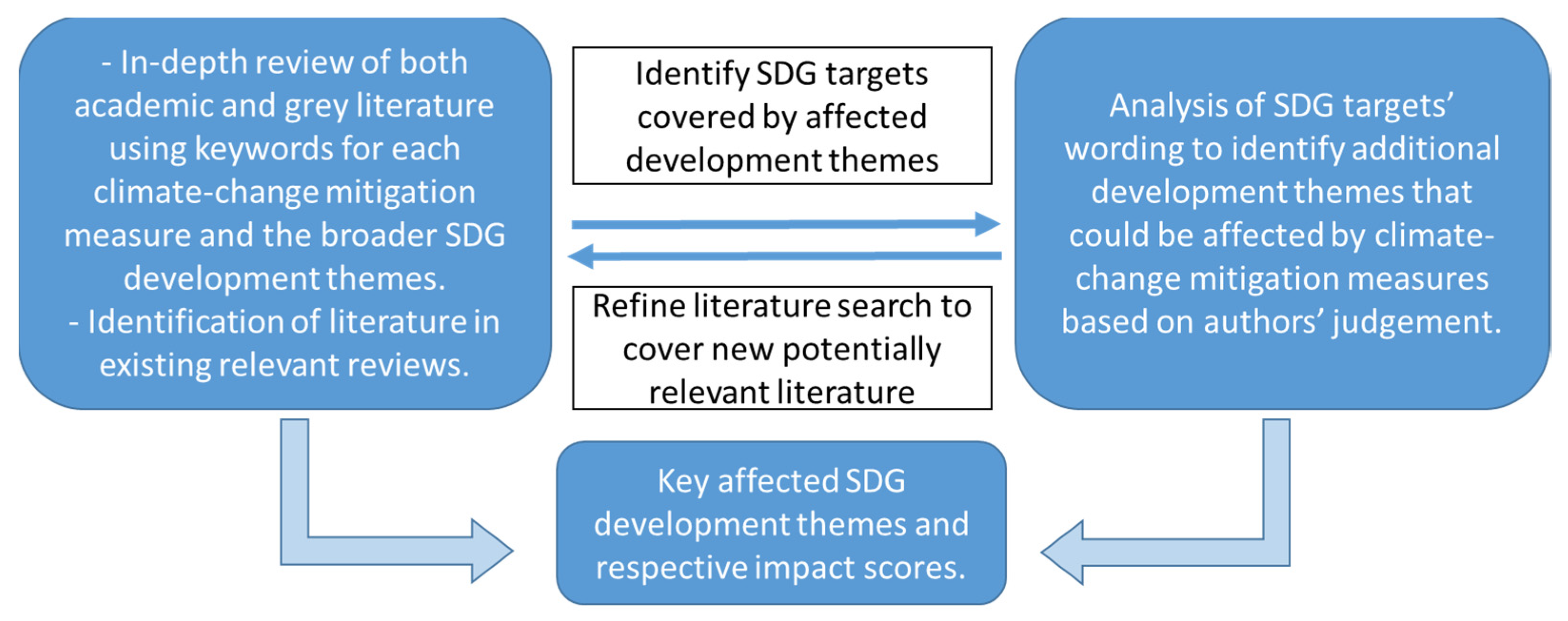
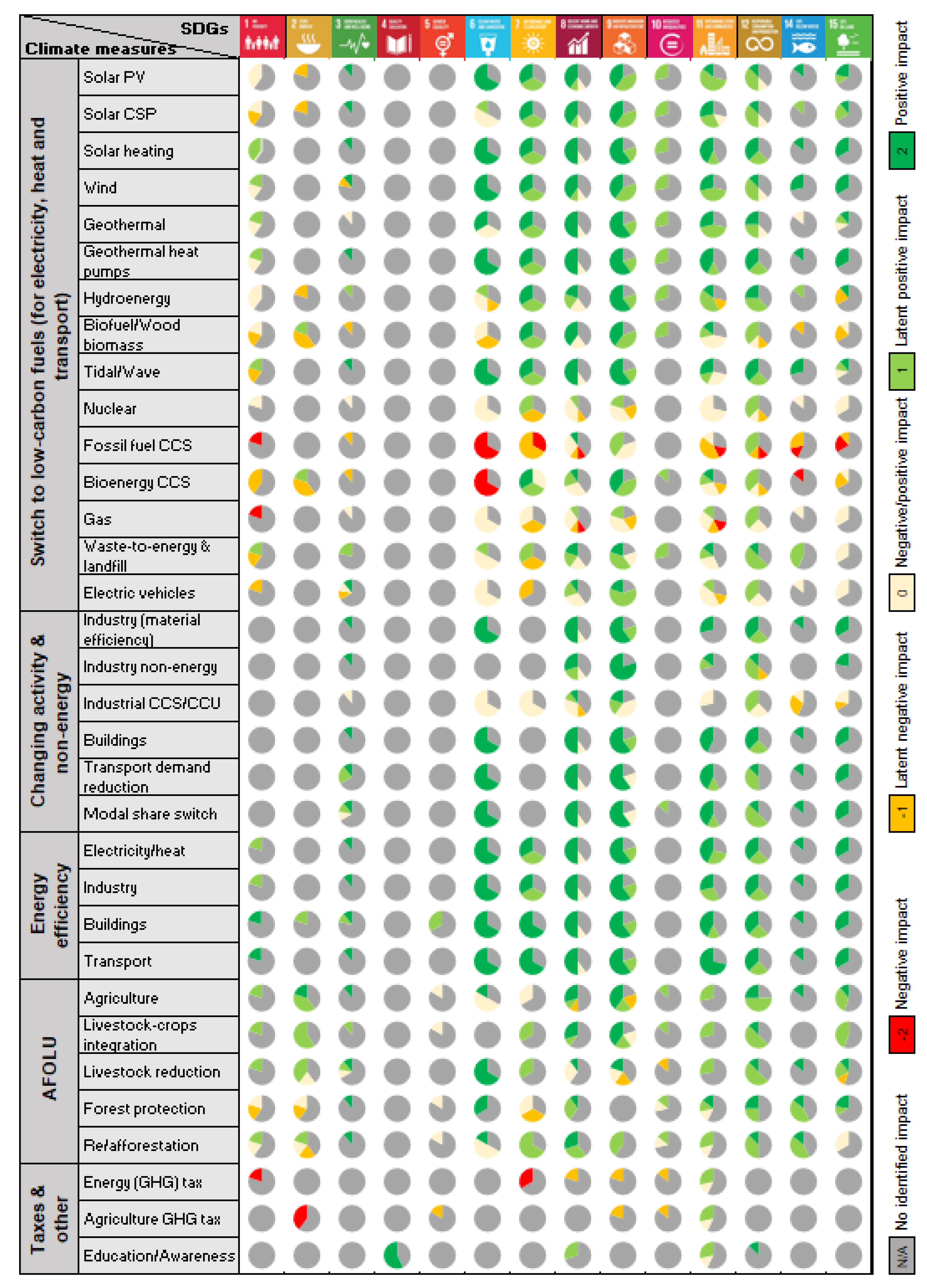
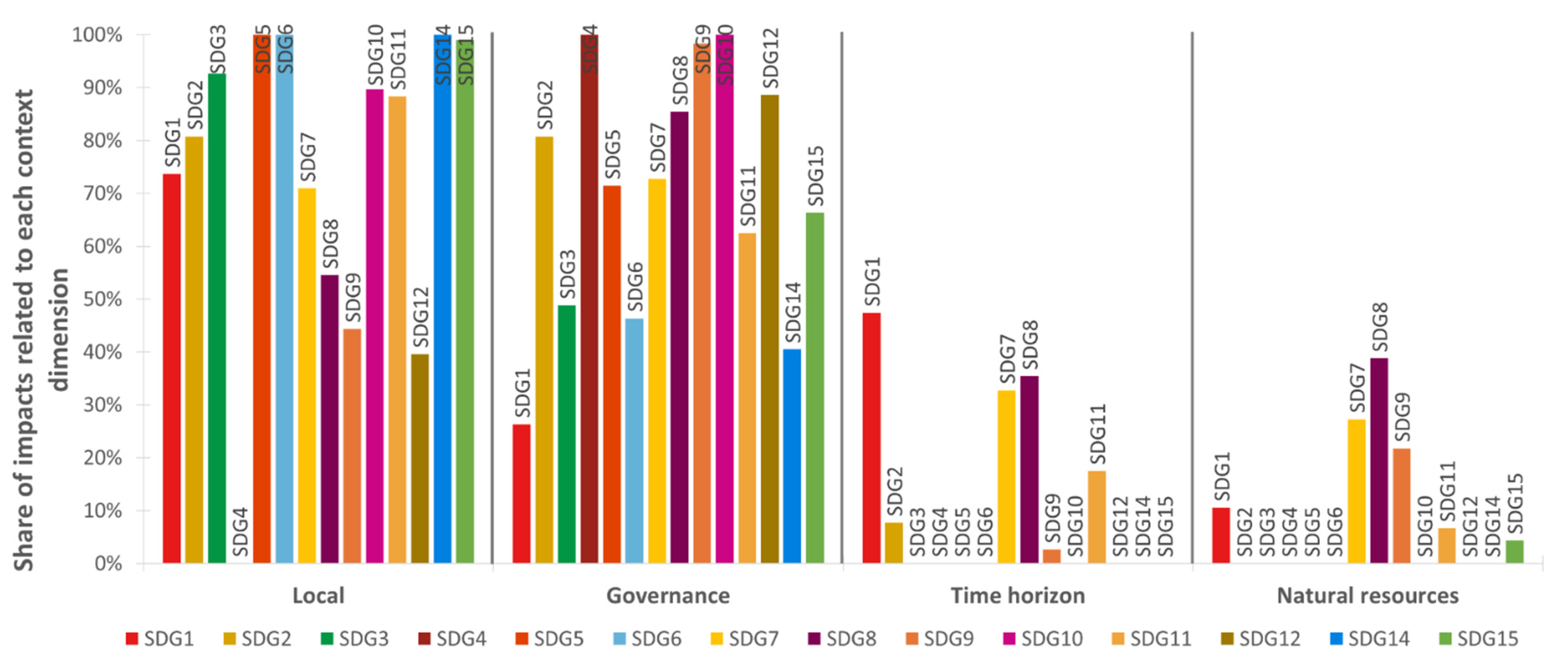
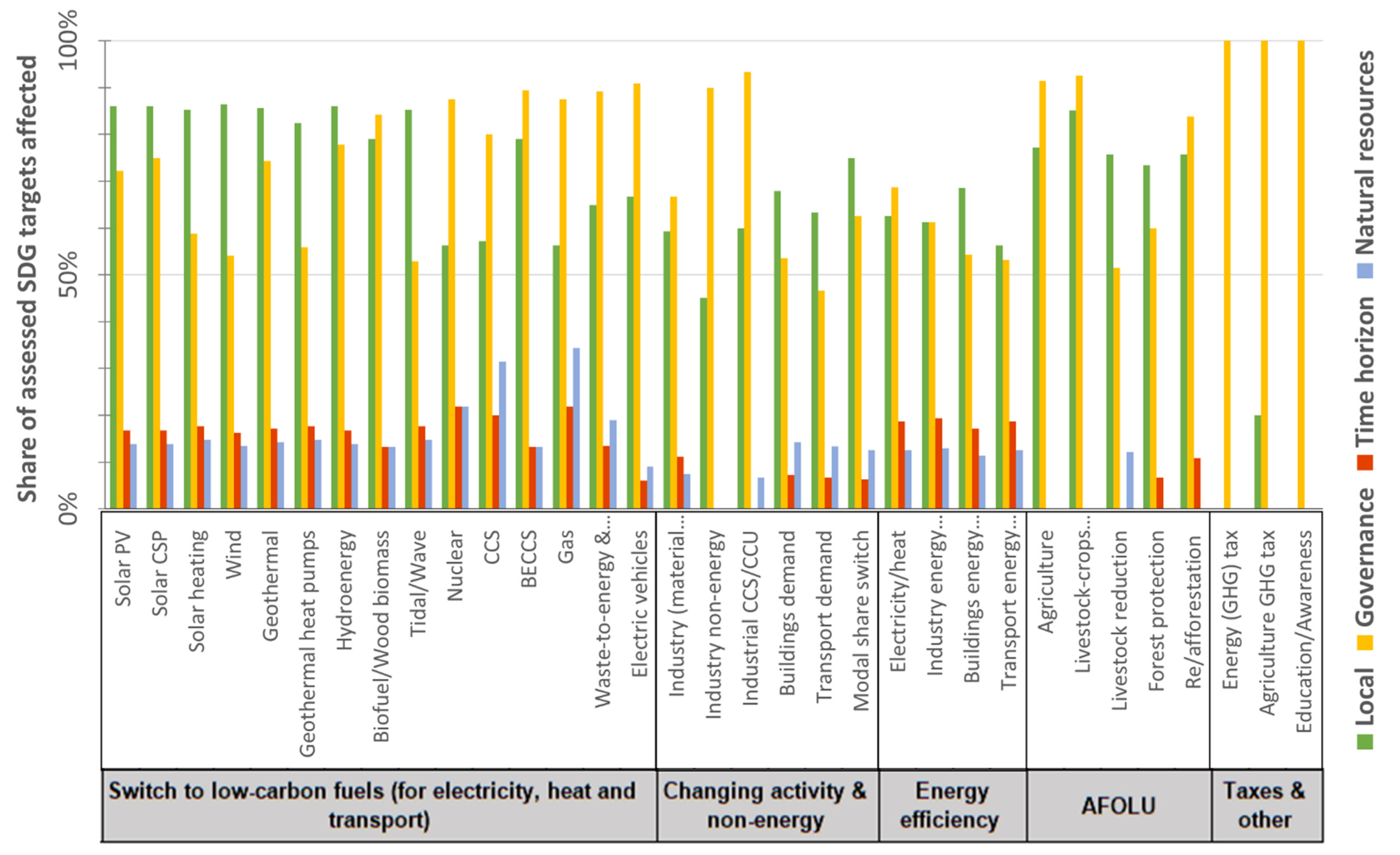
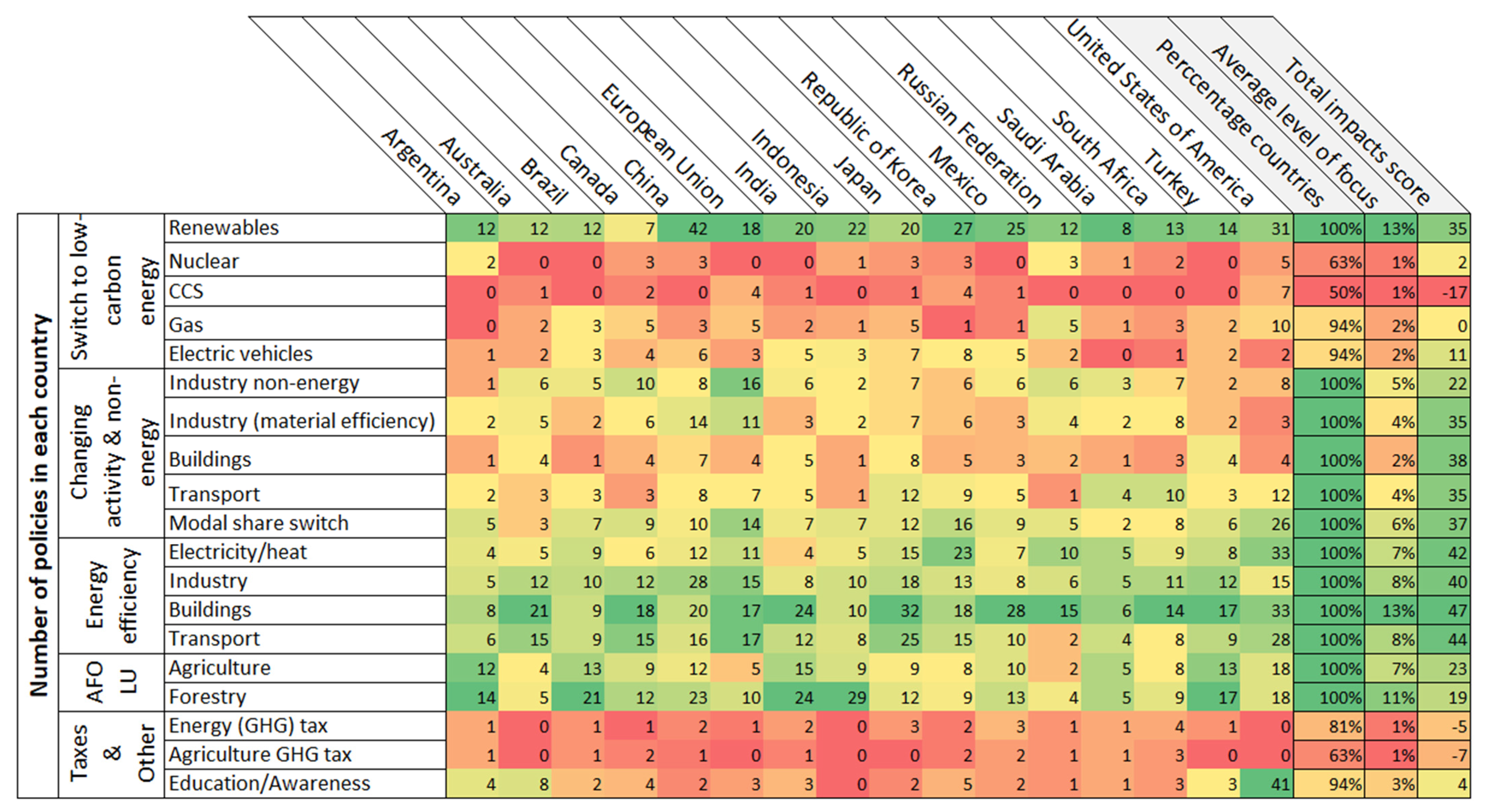
| Development Theme | SDG Targets | Development Theme | SDG Targets |
|---|---|---|---|
 Affordable energy (poverty) Affordable energy (poverty) | 1.2, 7.1, 11.1 |  Economic diversification Economic diversification | 8.2, 8.3, 9.5 |
 Energy access Energy access | 1.4, 7.1, 11.1 |  Tech./infrastructure upgrade Tech./infrastructure upgrade | 8.2, 9.5 |
 Land access Land access | 1.4, 2.3 |  Economic productivity Economic productivity | 8.2 |
 Food availability Food availability | 2.1 |  Decent/safe jobs Decent/safe jobs | 8.3, 8.8 |
 Agricultural jobs Agricultural jobs | 2.3 |  Resource efficiency Resource efficiency | 8.4, 9.4, 12.2, 12.5 |
 Agricultural productivity Agricultural productivity | 2.3, 2.4 |  Growth w/out env. degradation Growth w/out env. degradation | 8.4 |
 Farmers’ income Farmers’ income | 2.3 |  Job creation Job creation | 8.5 |
 Agri. infrastructure/knowledge Agri. infrastructure/knowledge | 2.3 |  Sustainable infrastructure Sustainable infrastructure | 9.1, 9.2 |
 Resilient and sust. agriculture Resilient and sust. agriculture | 2.4 |  Sustainable industrialization Sustainable industrialization | 9.2 |
 Communicable diseases Communicable diseases | 3.3 |  Inclusive industrialization Inclusive industrialization | 9.2 |
 Non-communicable diseases Non-communicable diseases | 3.4 |  Bottom 40% income growth Bottom 40% income growth | 10.1 |
 Mental health Mental health | 3.4 |  Inclusiveness Inclusiveness | 10.2 |
 Road safety Road safety | 3.6, 11.2 |  Adequate housing Adequate housing | 11.1 |
 Non-thermal water pollution Non-thermal water pollution | 3.9, 6.3, 14.1 |  Affordable housing Affordable housing | 11.1 |
 Air quality Air quality | 3.9, 11.6, 12.4 |  Public transport Public transport | 11.2 |
 Soil quality Soil quality | 3.9, 12.4, 15.3 |  Sustainable transport Sustainable transport | 11.2 |
 Training and education Training and education | 4.3, 4.4, 4.5, 4.7, 12.8 |  Sustainable settlements Sustainable settlements | 11.3 |
 Female discrimination Female discrimination | 5.1 |  Ecosystems/nature conservation Ecosystems/nature conservation | 11.4, 15.1, 15.5 |
 Domestic work support Domestic work support | 5.4 |  Environmetal impact of cities Environmetal impact of cities | 11.6 |
 Water efficiency & access Water efficiency & access | 6.1, 6.4 |  Waste management Waste management | 11.6, 12.5 |
 Thermal water pollution Thermal water pollution | 6.3, 14.1 |  Sust. corporate practices Sust. corporate practices | 12.2, 12.6 |
 Water ecosystems Water ecosystems | 6.6, 15.1 |  Sust. forest management Sust. forest management | 12.2, 15.2 |
 Modern energy sources Modern energy sources | 7.1 |  Food waste Food waste | 12.3 |
 Reliable energy Reliable energy | 7.1 |  Sust. public procurement Sust. public procurement | 12.7 |
 Renewable energy Renewable energy | 7.2 |  Coastal ecosystems protection Coastal ecosystems protection | 14.2, 14.5 |
 Energy efficiency Energy efficiency | 7.3 |  Marine economies Marine economies | 14.7 |
 Sustained economic growth Sustained economic growth | 8.1, 8.3 |
| 2 | 1 | 0 | −1 | −2 |
|---|---|---|---|---|
| This action always leads to the specified co-benefit. This impact can be enhanced by addressing the relevant context dimensions. | This action can lead to a co-benefit. This impact can be manifested and enhanced by addressing the relevant context dimensions. | The action can lead to a co-benefit or a trade-off. Favourable outcomes can be pursued by addressing the relevant context dimensions. | This action can lead to a trade-off. This impact can be reduced or completely avoided by addressing the relevant context dimensions. | This action always leads to a trade-off. This impact can be reduced by addressing the relevant context dimensions. |
Publisher’s Note: MDPI stays neutral with regard to jurisdictional claims in published maps and institutional affiliations. |
© 2021 by the authors. Licensee MDPI, Basel, Switzerland. This article is an open access article distributed under the terms and conditions of the Creative Commons Attribution (CC BY) license (https://creativecommons.org/licenses/by/4.0/).
Share and Cite
Iacobuţă, G.I.; Höhne, N.; van Soest, H.L.; Leemans, R. Transitioning to Low-Carbon Economies under the 2030 Agenda: Minimizing Trade-Offs and Enhancing Co-Benefits of Climate-Change Action for the SDGs. Sustainability 2021, 13, 10774. https://doi.org/10.3390/su131910774
Iacobuţă GI, Höhne N, van Soest HL, Leemans R. Transitioning to Low-Carbon Economies under the 2030 Agenda: Minimizing Trade-Offs and Enhancing Co-Benefits of Climate-Change Action for the SDGs. Sustainability. 2021; 13(19):10774. https://doi.org/10.3390/su131910774
Chicago/Turabian StyleIacobuţă, Gabriela Ileana, Niklas Höhne, Heleen Laura van Soest, and Rik Leemans. 2021. "Transitioning to Low-Carbon Economies under the 2030 Agenda: Minimizing Trade-Offs and Enhancing Co-Benefits of Climate-Change Action for the SDGs" Sustainability 13, no. 19: 10774. https://doi.org/10.3390/su131910774
APA StyleIacobuţă, G. I., Höhne, N., van Soest, H. L., & Leemans, R. (2021). Transitioning to Low-Carbon Economies under the 2030 Agenda: Minimizing Trade-Offs and Enhancing Co-Benefits of Climate-Change Action for the SDGs. Sustainability, 13(19), 10774. https://doi.org/10.3390/su131910774







